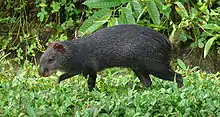Black agouti
The black agouti (Dasyprocta fuliginosa) is a South American species of agouti from the family Dasyproctidae.
| Black agouti | |
|---|---|
 | |
| Scientific classification | |
| Domain: | Eukaryota |
| Kingdom: | Animalia |
| Phylum: | Chordata |
| Class: | Mammalia |
| Order: | Rodentia |
| Family: | Dasyproctidae |
| Genus: | Dasyprocta |
| Species: | D. fuliginosa |
| Binomial name | |
| Dasyprocta fuliginosa Wagler, 1832 | |
Distribution and habitat
It is found in the northwestern Amazon in southern Venezuela, eastern Colombia, eastern Ecuador, western Brazil and northeastern Peru. There is also a disjunct population in the Magdalena River Valley of northern Colombia.[1] They are found in forests, thick brush, savannas, and cultivated areas. In Peru, they are confined to the Amazonian region where they are found in all parts of the low selva zone and many parts of the high selva zone. It is found at altitudes of 2,000 metres (6,600 ft) and above. Agoutis live in close proximity to water, being found on the banks of all types of streams.
Description
It is overall black grizzled white, and the throat is white.[2] The black agouti weighs 3.5–6 kg (7.7–13.2 lb).
Behavior
Like other agoutis, the black agouti is diurnal, lives alone or in pairs, and feeds on fruits and nuts.[2] In some areas, they construct burrows among limestone boulders, along river banks, or under the roots of trees.
Reproduction
The female black agouti is capable of breeding year-round. Also, they are considered to be seasonally polyestrous, meaning the females can go through more than one period of estrus in a single year.[3] One estrus period can last for 24 hours while the estrous cycle can last between 30 and 34 days.[3] Furthermore, the gestation period averages 104 days, and females are able to produce two newborns per litter.[3]
References
- Catzeflis, F.; Patton J.; Percequillo, A.; Weksler, M. (2016). "Dasyprocta fuliginosa". IUCN Red List of Threatened Species. 2016: e.T6281A22197874. doi:10.2305/IUCN.UK.2016-2.RLTS.T6281A22197874.en. Retrieved 12 November 2021.
- Emmons, L. H. (1997). Neotropical Rainforest Mammals. Pp. 227. 2nd edition. ISBN 0-226-20721-8
- Mayor, P., et al. (2011). Functional anatomy of the female genital organs of the wild black agouti (Dasyprocta fuliginosa) female in the Peruvian Amazon. Animal Reproduction Science. 123 (3-4), 249-257.
- John F. Eisenberg and Kent H. Redford, 2000. Mammals of Neotropics: Ecuador, Bolivia and Brazil.
